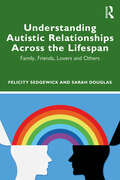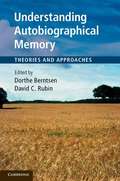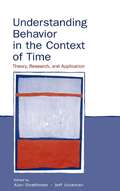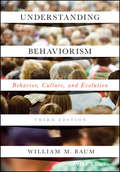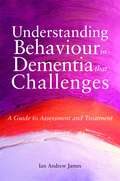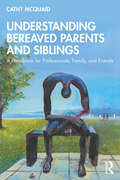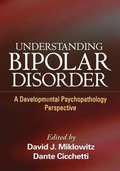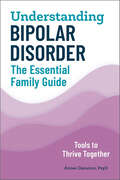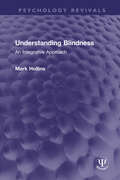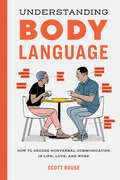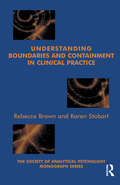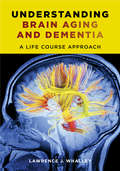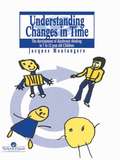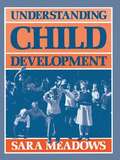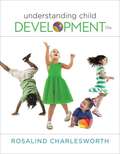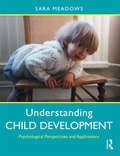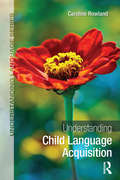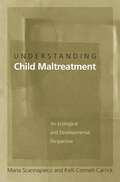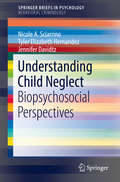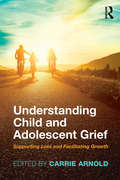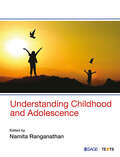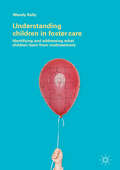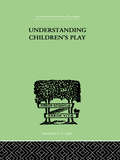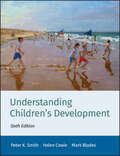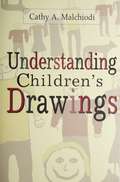- Table View
- List View
Understanding Autistic Relationships Across the Lifespan: Family, Friends, Lovers and Others
by Felicity Sedgewick Sarah DouglasUnderstanding Autistic Relationship Across the Lifespan is an accessible overview of autistic relationships from the early years through to old age. This much-needed book combines the latest research findings with first-hand accounts to offer insight into the relationships of autistic people and how they differ to those of non-autistic people in a range of ways. Felicity Sedgewick and Sarah Douglas delve into life's stages and their challenges, revealing how navigating relationships can lead to misunderstandings, rejection, and trauma – but also to genuine connection, support, and joy. Illustrated throughout with extracts from interviews, and with extended narratives from Sarah, it explores key topics including relationships in the early years, childhood friendships, teenage friendships and romance, adult romantic and sexual relationships, LGBTQ+ relationships, finding community, family relationships, and issues in the later stages of life. The authors explore a wide range of emotions and life situations, examining the social world of autistic people and the strategies they use to navigate it. Understanding Autistic Relationship Across the Lifespan offers practical recommendations for both autistic and non-autistic people on how to have the healthiest and most satisfying relationships possible. It is essential reading for all those working with autistic people and studying autism, as well as autistic individuals and those close to them.
Understanding Autobiographical Memory
by Dorthe Berntsen David C. RubinThe field of autobiographical memory has made dramatic advances since the first collection of papers in the area was published in 1986. Now, over 25 years on, this book reviews and integrates the many theories, perspectives, and approaches that have evolved over the last decades. A truly eminent collection of editors and contributors appraise the basic neural systems of autobiographical memory; its underlying cognitive structures and retrieval processes; how it develops in infancy and childhood, and then breaks down in aging; its social and cultural aspects; and its relation to personality and the self. Autobiographical memory has demonstrated a strong ability to establish clear empirical generalizations, and has shown its practical relevance by deepening our understanding of several clinical disorders - as well as the induction of false memories in the legal system. It has also become an important topic for brain studies, and helped to enlarge our general understanding of the brain.
Understanding Behavior in the Context of Time: Theory, Research, and Application
by Alan Strathman Jeff JoiremanUnderstanding Behavior in the Context of Time reviews the research on temporal orientation and brings together the disparate social behaviors influenced by time perspective. Organized into four sections, each chapter includes theory, research, applications, and directions for future research. Some chapters outline novel theoretical approaches that help to expand and/or integrate existing theories. The second part focuses on individual level processes and reviews the conceptualization, measurement, and lifespan development of time orientation; the outcomes associated with various time orientations; and how temporal factors influence attitudes and persuasion. Part three explores the role of time within interpersonal and group level processes as applied to such areas as close relationships, group cooperation, aggression, organizational behavior, pro-environmental behavior, and cultural issues.This book will be of interest to social and personality psychologists, and the book's applied emphasis will appeal to health, environmental, and industrial psychologists.
Understanding Behaviorism: Behavior, Culture, and Evolution
by William M. BaumUnderstanding Behaviorism is a classic textbook that explains the basis of behavior analysis and its application to human problems in a scholarly but accessible manner. Now in its third edition, the text has been substantially updated to include the latest developments over the last decade in behaviour analysis, evolutionary theory, and cultural evolution theory The only book available that explains behavior analysis and applies it to philosophical and practical problems, written by one of today’s best-known and most highly respected behaviorists Explores ancient concepts such as purpose, language, knowledge, and thought, as well as applying behavioural thinking to contemporary social issues like freedom, democracy, and culture Part of the new evolutionary perspective for understanding individual behavior in general and culture in particular – culminates with practical approaches to improving the lives of all humanity
Understanding Behaviour in Dementia that Challenges: A Guide to Assessment and Treatment (Bradford Dementia Group Ser.)
by Ian Andrew James*Highly Commended in the Health and Social Care category at the 2012 British Medical Association Book Awards*Behaviours that challenge can significantly interfere with the quality of life of a person with dementia, as well as that of those who live with and care for them. Yet there is a great deal of confusion surrounding how such behaviours should be addressed. This book provides theory and practical guidance on the assessment and treatment of behaviours that challenge in dementia, with a particular emphasis on non-pharmacological approaches. The author describes the different categories and causes of challenging behaviour in people with dementia, and provides tried-and-tested models which will aid identification, assessment and treatment. A thorough evaluation of the use of psychotropic medication is provided, as well as of a wide range of psychological and biopsychosocial interventions. The book contains useful tools and protocol derived from the author's work at a specialist challenging behaviour unit, as well as case studies which demonstrate how the various models may be used in practice. This will be an invaluable resource for any professional involved in the assessment and treatment of behaviours that challenge in people with dementia, including psychiatrists, psychologists, community psychiatric nurses, GPs and occupational therapists. It will also be of interest to those involved in commissioning, providing and managing services.
Understanding Bereaved Parents and Siblings: A Handbook for Professionals, Family and Friends
by Cathy McQuaidUnderstanding Bereaved Parents and Siblings is based on lived experiences and provides insight, ideas, and inspiration on how to support the bereaved, how to talk to them about their experience, and how to help people manage their own shock or grief. Part I of the book contains ten stories from parents and six from siblings sharing their experiences. Each narrator discusses their relationship with the person who died; what led up to the death; the impact of the loss on the speaker; as well as what helped and what hindered them in their grief. Part II is aimed at professionals and draws on various topics such as grief and bereavement models, transgenerational loss, resilience, protection, and creative ways of working with grief. The book will be an essential read for the bereaved and the professionals, family, and friends who are supporting them.
Understanding Bipolar Disorder
by David Miklowitz Dante CicchettiThis is the first book to systematically examine the development and course of bipolar disorder across the lifespan, identifying important directions for evidence-based treatment and prevention. The editors and contributors are foremost authorities who synthesize cutting-edge research at multiple levels of analysis, including genetic, neurobiological, cognitive, emotional, and family perspectives. Compelling topics include how bipolar symptoms change from childhood through adolescence and adulthood and the interplay of risk and protective factors at different developmental stages. The volume also addresses how developmental knowledge can inform the selection and timing of clinical interventions.
Understanding Bipolar Disorder: Tools to Thrive Together
by Aimee DaramusA compassionate approach to understanding and supporting loved ones with bipolar disorderIf your loved one was recently diagnosed with bipolar disorder, you probably have a lot of questions and concerns about how to help them live the healthiest life possible. Understanding Bipolar Disorder answers those questions and offers helpful guidance with essential information, practical strategies, and support for families of people suffering from bipolar disorder.Learn about what bipolar is, how it's diagnosed, the science behind it, and the treatments available, including medication, therapies, and community support. You'll find effective tools for dealing with a diagnosis as a family, advice for exploring therapy options as a team, and simple techniques for managing your family's stress levels to prevent emotional burnout.Understanding Bipolar Disorder includes:Relatable anecdotes—Read about what it's like to have bipolar disorder and to live with someone who has it.Family friendly activities—Explore exercises and questions you can work through together so you can learn how to best support your loved one with bipolar.Tools for thriving together—Discover tools that help you flourish as a family, including advice for getting ahead of moods, setting boundaries, maintaining healthy relationships, self-care, and more.Take the first step toward understanding and managing bipolar disorder—together.
Understanding Blindness: An Integrative Approach (Psychology Revivals)
by Mark HollinsOriginally published in 1989, much was known about blindness, but the field was divided into specialties. Experts in the different areas were widely dispersed among university departments, rehabilitation agencies, and school systems, with the result that people in one specialty area often knew little about developments in other areas. It was hoped that this work would be useful in reducing that isolation, by presenting, within a single volume, basic information derived from different approaches to the subject of blindness. Individuals already familiar with material in some of the chapters could gain added perspective on the field as a whole by reading about other aspects of blindness outside their specialty area.
Understanding Body Language: How to Decode Nonverbal Communication in Life, Love, and Work
by Scott RouseBecome more successful in every interaction by learning to read body language Scientific studies show that people use body language to express their true feelings about a given situation or topic. With Understanding Body Language, you'll discover essential information and how-to guidance for deciphering nonverbal communication so you can make better decisions about the people and situations you approach every day.Start by learning how to properly observe people so you can uncover their subtle nonverbal cues without drawing attention to yourself. Then, practice on your friends and family with practical advice to help you better read social gatherings and telltale signs of disagreement. Finally, dive deeper with real-life scenarios you'll likely encounter, such as dating, job interviews, and workplace interactions.Understanding Body Language includes:Body language 101—Explore the science and driving forces behind body language, best practices for your own expression, and tips for successful interpretation of others.In-the-moment guidance—Learn setting-specific how-tos to help you feel physically assured in difficult situations, such as using positive body language while on a date and projecting confidence within the workplace.An emotional connection—Discover the link between specific emotions and the associated body language so you can apply that vital knowledge in real time and use it to your advantage.Learn to decode body language with this complete guide to understanding nonverbal communication.
Understanding Boundaries and Containment in Clinical Practice (The Society of Analytical Psychology Monograph Series)
by Rebecca Brown Karen StobartThe authors propose to investigate the meaning and purpose of boundaries within and around the therapeutic experience. A boundary is more than a simple line delineating one space from another; it is an entity with properties that demand a response if they are to be negotiated. Boundaries circumscribe a space that can be viewed objectively, or experienced subjectively, as a 'container'. For the uninitiated, this therapeutic container can be difficult to penetrate. Even health professionals such as GPs and psychiatrists often do not know how to access psychotherapy organisations and their referral networks. Also, real constraints on the availability of counselling and psychotherapy within the National Health Service, and the cost of private sector services, may prohibit access to the help being sought. The book explores aspects such as the gradual evolution of therapeutic boundaries in psychodynamic work, boundary development in infancy and childhood, the role of the therapist's mind and the therapeutic setting, confidentiality and issues such as money and time.
Understanding Brain Aging and Dementia: A Life Course Approach
by Lawrence WhalleyThe life course method compares an individual's long-life and late-life behaviors to gauge one's mental decay. Arguing the life course approach is the best and simplest model for tracking mental development, Lawrence J. Whalley unlocks the mysteries of brain functionality, illuminating the processes that affect the brain during aging, the causes behind these changes, and effective coping strategies. Whalley identifies the genetic factors that determine the pace of aging and the behaviors, starting in childhood, that influence how we age. Through vignettes, charts, and tables, he composes an accessible book for patients, family members, and caretakers struggling to make sense of a complex experience.
Understanding Changes In Time: The Development Of Diachronic Thinking In 7-12 Year Old Children
by Jacques Montangero University of Geneva, Switzerland.This text provides an analysis of how children come to be able to understand the dynamic nature of causality - how processes take place through time. The author studies the capabilities and limitations of 7-12 year old children in order to assess their conception of evolutionary processes. His study follows on from Piaget's work on causality, and is intended to contribute to the literature on "theory of mind" and children's scientific development. The book draws on experimental studies of diachronic thinking in children and adults, and discusses the importance of a well-developed diachronic perspective for cognition.
Understanding Child Development
by Sara MeadowsThis highly readable text provides an exceptionally clear overview of the whole field of child development, from birth to adolescence. the 2-12 age range is strongly emphasised. All the main areas of child development are fully covered: * perception and understanding* cognitive skills* play and language* personality* social relationshipsThe author draws upon the studies from a wide range of disciplines and shows how these contribute to our understanding of child development, clearly demonstrating how the information can be applied at home and school.
Understanding Child Development (Mindtap Course List)
by Rosalind CharlesworthThis book is a standalone book and will not include any access codes. <P><P>UNDERSTANDING CHILD DEVELOPMENT, 10th Edition, introduces you to the unique qualities of young children from infants to age eight, and demonstrates how to work with each child in ways that correspond with their developmental level, and their social and cultural environment. Learning theories and research are included, as is information about the importance of play and technology in a young child's learning process. <P><P>Learning objectives and specific NAEYC Program Standards, Accreditation Criteria, and Developmentally Appropriate Practices (DAP) are highlighted at the beginning of each chapter. Other topics covered include readiness, assessment, working with children and families from diverse cultures, working with children with special needs, and the early stages of reading, writing, and general cognitive development. Throughout the text, real-life examples and anecdotes bring theory and research to life
Understanding Child Development: Psychological Perspectives and Applications
by Sara MeadowsUnderstanding Child Development introduces the main areas of developmental psychology in childhood. Drawing on content which first appeared in ‘Understanding Child Development’, published in 1986, the book includes new bases of evidence and offers an interdisciplinary approach to the subject. Following a thematic approach, this book draws together strands of knowledge from psychology, neuroscience, and medical, social and cognitive sciences. It covers both classic and contemporary theories and research, while also examining child development in real-world settings. Chapters explore conceptual issues, key developmental theories, and research methodology, while developing practical ways of making children’s lives better. These discussions are presented in a refreshing tone giving the reader an insight into the broad area of developmental psychology and its applications. Written in an engaging and accessible style, Understanding Child Development is essential reading for students on introductory courses in developmental psychology. It also offers valuable reading for those on related courses in education, health and social work.
Understanding Child Language Acquisition (Understanding Language)
by Caroline RowlandTaking an accessible and cross-linguistic approach, Understanding Child Language Acquisition introduces readers to the most important research on child language acquisition over the last fifty years, as well as to some of the most influential theories in the field. Rather than just describing what children can do at different ages Rowland explains why these research findings are important and what they tell us about how children acquire language. Key features include: Cross-linguistic analysis of how language acquisition differs between languages A chapter on how multilingual children acquire several languages at once Exercises to test comprehension Chapters organised around key questions that summarise the critical issues posed by researchers in the field, with summaries at the end Further reading suggestions to broaden understanding of the subject With its particular focus on outlining key similarities and differences across languages and what this cross-linguistic variation means for our ideas about language acquisition, Understanding Child Language Acquisition forms a comprehensive introduction to the subject for students of linguistics, psychology and speech and language therapy. Students and instructors will benefit from the comprehensive companion website that includes a students’ section featuring interactive comprehension exercises, extension activities, chapter recaps and answers to the exercises within the book. Material for instructors includes sample essay questions, answers to the extension activities for students and a Powerpoint including all the figures from the book. www.routledge.com/cw/rowland
Understanding Child Maltreatment: An Ecological And Developmental Perspective
by Maria Scannapieco Kelli Connell-CarrickChild maltreatment professionals from all disciplines struggle to find better ways of understanding and treating the families and children affected by maltreatment. Since the mid-1960s, the "battered child syndrome," and recent high-profile abuse cases, a plethora of research and literature on child maltreatment has emerged, yet this is the first volume to offer a comprehensive integrated analysis for understanding, assessing, and treating child maltreatment within the ecological framework in a developmental context. This framework systematically organizes and integrates the complex empirical literature in child maltreatment and development, including the often-overlooked period of adolescence. Viewing child maltreatment from an ecological perspective, this volume identifies the risk and protective factors correlated with abuse and neglect. The authors present a comprehensive assessment framework, addressing the multiple developmental and environmental factors unique to each case. This framework fully considers risk and protective factors and their relationship to individuals, families, and environmental elements, presenting a much-needed perspective for today's child protective services workers. Understanding Child Maltreatment is the first of its kind. While most books broadly address the developmental consequences of maltreatment, this volume goes further by proposing assessment and intervention strategies based on a deep understanding of each stage of a child's development. Interventions center on the caregiver and the family, with particular attention to parenting skills and the challenges the child may experience within his or her developmental stage. Each chapter emphasizes empirically based interventions and includes a case illustration that guides readers in applying these concepts to their own practice. Providing a comprehensive, nuanced perspective on maltreatment, this book will be invaluable to students, researchers, and professionals.
Understanding Child Neglect: Biopsychosocial Perspectives (SpringerBriefs in Psychology)
by Nicole A. Sciarrino Tyler Elizabeth Hernandez Jennifer DavidtzThis concise book reviews the various types of neglect in childhood, providing an operational definition that incorporates existing viewpoints. It describes risk factors for neglect to increase awareness for improved identification, prevention, and treatment of this pervasive problem. This is particularly important as neglect is a growing worldwide issue which receives less attention than more florid forms of abuse. The book aims to facilitate conceptualization and treatment of adult clients who have suffered neglect as well as treatment plans for at risk home environments.
Understanding Child and Adolescent Grief: Supporting Loss and Facilitating Growth (Series in Death, Dying, and Bereavement)
by Carrie ArnoldUnderstanding Child and Adolescent Grief incorporates theory, clinical applications, case studies, and current research on contemporary models of grief pertaining to children and adolescents. The integration of developmental perspectives, attachment theory, and neurobiological implications provides a thorough summary of the many factors that can affect a child's growth and development, and the subsequent influence on grief expression. Chapters explore relevant social topics rarely addressed in other texts, such as the death of African American men, suicide among Aboriginal youth in Canada, death/suicide among LGBTQ youth and social media's influence. Also included are practical tips for helping professionals who want to better understand how grief and loss affect children and teens, as well as a meditation guide that provides concrete opportunities for growth and healing.
Understanding Childhood and Adolescence
by Namita RanganathanThe book will serve as a helpful reference for undergraduate and post-graduate students of Psychology and Education. Understanding the nature of a child or learner, the context in which they live and grow, and building perspective on the process of development forms the basic framework for all courses in Education. This book focuses on human development and diversity as the dominant themes that cut across early, middle and late childhood, and adolescence, which in turn correspond to the pre-primary, primary, secondary and senior secondary levels of schooling. Understanding Childhood and Adolescence links existing theories in educational psychology with concerns of contemporary Indian society. It covers early childhood care and education; socio-cultural, philosophical, and psychological perspectives on childhood and adolescence; contemporary lifestyle changes affecting these life-stages; and concerns of diversity ranging from multilingualism, gender, to intelligence and development of self and identity. The textually informative chapters cover the historical trajectory and important theories of each life-stage, and raise relevant debates and issues related to each of them. Key Features: • Looks at childhood and adolescence from multiple contours such as developmental aspects, issues, trends, challenges, interface with society, its institutions and policy provisions • Traces historical evolution of the basic concepts and contextualizes these to the Indian socio-cultural milieu through examples and cases • Discusses key concepts related to compulsory foundational courses in development and diversity in all teacher education programmes • Contains mid-chapter exercises and chapter-end questions to help readers check their understanding as well as reflect on issues in teaching - learning processes
Understanding Children in Foster Care
by Wendy KellyThis book introduces the Relational Learning Framework (RLF), an assessment tool which helps foster care practitioners, social workers and foster carers to examine what foster children have learned in their early life about relationships and particularly through maltreatment. Grounded in attachment theory and drawing on cognitive theory this book will help practitioners to understand and respond to the challenging behaviour presented by these children and remove barriers to an empathic response. Early chapters provide context in a theoretical discourse on the causes and consequences of psychological and attachment difficulties for children in care, including a discussion of maltreatment and foster care. The theoretical basis of the technique will be outlined and subsequent chapters will explain how to undertake RLF including the wide-ranging practice evidence, a worked example, common themes and trouble shooting. This will be an invaluable source for clinical practitioners, social workers, foster care practitioners and foster parents who want to make sense of the complex information about children in foster care to improve their relationships. It will also provide insight into foster children's mental health and behaviour for academics and postgraduate students in related disciplines.
Understanding Children'S Play
by Ruth E. Hartley Lawrence K. Frank Robert GoldensonFirst Published in 1999. Routledge is an imprint of Taylor & Francis, an informa company.
Understanding Children's Development (Basic Psychology)
by Peter K. Smith Helen Cowie Mark BladesUnderstanding Children's Development is the UK's best-selling developmental psychology textbook and has been widely acclaimed for its international coverage and rigorous research-based approach. <p><p> This dynamic text emphasizes the practical and applied implications of developmental research. It begins by introducing the ways in which psychologists study developmental processes before going on to consider all major aspects of development from conception through to adolescence.
Understanding Children's Drawings
by Cathy A. MalchiodiThis practical resource demonstrates how all clinicians can broaden and enhance their work with children by integrating drawing into therapy. The book enables therapists to address the multidimensional aspects of children's art without resorting to simplistic explanations. Approaching drawing as a springboard for communication and change, Malchiodi offers a wealth of guidelines for understanding the intricate messages embedded in children's drawings and in the art-making process itself. Topics covered include how to assist children in making art, what questions to ask and when, and how to motivate children who are initially resistant to drawing. Assimilating extensive research and clinical experience, the book includes over 100 examples of children's work.
